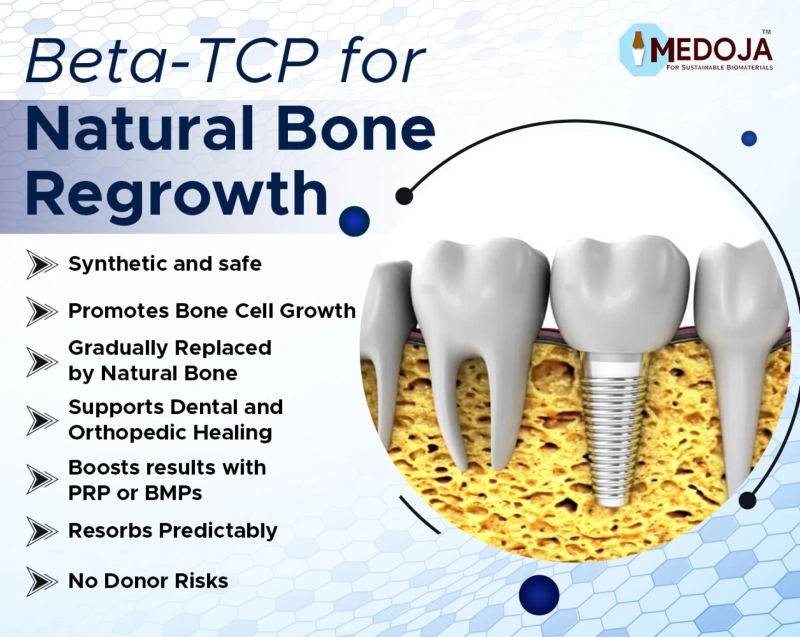Bone tissue has an extraordinary ability to heal and regenerate when injured or damaged. However, in certain clinical cases where the defect is too large or healing is compromised, the use of bone grafts becomes necessary to support and stimulate the natural bone regeneration process. Among the synthetic options available, Beta-Tricalcium Phosphate (Beta-TCP) has emerged as a highly effective and biocompatible material for bone grafting, particularly in orthopedic and dental procedures. This article delves into how Beta-TCP bone grafts contribute to bone healing and regrowth, their mechanism of action, benefits, and clinical applications.
What is Beta-Tricalcium Phosphate (Beta-TCP)?
Beta-Tricalcium Phosphate, commonly referred to as Beta-TCP, is a synthetic ceramic composed of calcium and phosphate in a 3:2 ratio. Chemically similar to the mineral components of bone, Beta-TCP is resorbable and osteoconductive, meaning it provides a scaffold that facilitates the growth of new bone tissue. Over time, the material dissolves and is replaced by the patient’s own bone. Unlike autografts (bone taken from the patient’s own body) or allografts (donor bone), Beta-TCP bone substitute eliminates the risks of disease transmission, donor site morbidity, and limited supply, making it an ideal solution for a wide range of bone regeneration procedures.
Beta-TCP for Bone Healing: The Science Behind It
Beta-TCP acts primarily through osteoconduction. This means that once implanted, it serves as a scaffold or framework that encourages bone-forming cells, such as osteoblasts, to migrate, adhere, and proliferate within the grafted area. The micro-porous structure of Beta-TCP allows for vascularization, which is critical for the survival and function of new bone tissue. As the healing progresses, Beta-TCP gradually degrades, and the newly formed bone tissue takes its place. This resorbable nature ensures that the graft material does not remain as a foreign body, thus reducing long-term complications. Additionally, Beta-TCP may exhibit osteoinductive properties when combined with bioactive molecules or stem cells. While it is not inherently osteoinductive, its compatibility with growth factors allows it to support more complex healing scenarios.
Clinical Applications of Beta-TCP Bone Grafts
Beta-TCP is widely used in both orthopaedic and dental surgery due to its favourable properties.
Orthopaedic Applications
- Fracture repair: Beta-TCP is used in the management of non-union or delayed union fractures.
- Spinal fusion: It serves as a bone graft extender or substitute in spinal surgeries.
- Bone defects: It is effective in filling voids caused by trauma, tumors, or infections.
- Joint reconstruction: Used as a bone graft material in joint revision surgeries, such as knee or hip arthroplasty.
Dental and Maxillofacial Applications
- Dental bone grafting: Beta-TCP is extensively used as a synthetic dental bone graft to support dental implants.
- Socket preservation: It is placed in the socket after tooth extraction to preserve bone volume.
- Sinus lift procedures: Used in maxillary sinus augmentation before implant placement.
- Periodontal defects: Beta-TCP aids in regenerating bone lost due to periodontal disease.
In all these applications, Beta-TCP for bone healing demonstrates excellent biocompatibility, predictability, and a low risk of immunogenic reactions.
Benefits of Using Beta-TCP Bone Grafts
The popularity of Beta-TCP in regenerative medicine is largely due to the numerous advantages it offers:
- Biocompatibility
Beta-TCP is well-tolerated by the human body and does not provoke an immune response. Its chemical similarity to natural bone makes it an ideal candidate for grafting.
- Controlled Resorption
One of the defining features of Beta-TCP is its predictable degradation rate. It dissolves in the body over time at a rate that closely matches the pace of new bone formation.
- Structural Support
The porous structure of Beta-TCP supports the in-growth of capillaries and bone cells. Its rigidity provides mechanical support during the initial healing phase.
- Versatility
Beta-TCP can be used alone or combined with other materials such as hydroxyapatite or collagen to enhance its performance. It is available in granules, blocks, or moldable putties to suit different surgical needs.
- Reduced Risk
Because Beta-TCP is a synthetic bone graft material, it eliminates the risks associated with donor tissues, such as infection or rejection.
Beta-TCP in Combination with Other Materials
In many clinical settings, Beta-TCP is used in combination with hydroxyapatite (HA) to optimize both osteoconductive and mechanical properties. While Beta-TCP resorbs relatively quickly, HA is more stable and resorbs slowly. A combination of these two can provide a balanced scaffold that supports long-term healing. Additionally, Beta-TCP can be used with platelet-rich plasma (PRP) or bone morphogenetic proteins (BMPs) to enhance its osteoinductive potential. This combination has been particularly beneficial in complex grafting scenarios or patients with compromised healing capacity.
Future of Beta-TCP in Bone Grafting
The demand for synthetic bone substitutes is on the rise, driven by advancements in biomaterials and the need for safer, more accessible options. Ongoing research aims to improve the bioactivity of Beta-TCP through nanotechnology, surface modifications, and the inclusion of growth factors. Moreover, 3D-printed Beta-TCP scaffolds are being developed to match patient-specific bone defects, offering personalized solutions for bone regeneration. By acting as a temporary scaffold that is gradually replaced by natural bone, Beta-TCP supports bone healing and regrowth in a manner that closely mimics the body’s own regenerative processes. As clinical outcomes continue to support its use, Beta-TCP remains a vital tool in advancing regenerative medicine.



